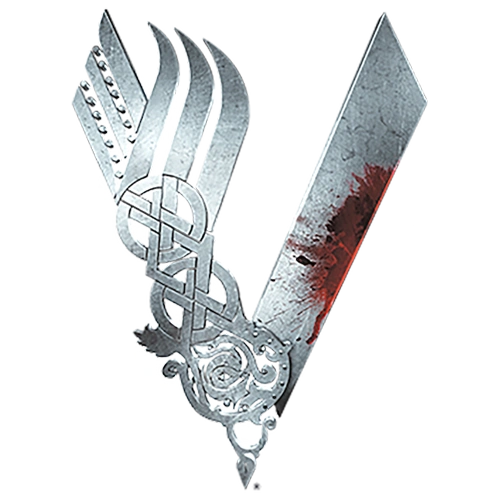Runes are the principal writing system in Scandinavia.
Runic History[]
Runic inscriptions appeared first in Denmark in the first centuries AD. They were probably inspired by the Latin alphabet, but took on their own significance among Germanic peoples. Like the Latin alphabet is called "alphabet" due to the first letters being alpha (A) and beta (B), a runic alphabet is called a futhark because it derives from their first six letters of the alphabet, "f," "u," "th," "a," "r," and "k." There are several futharks due to the changes in the languages of the Germanic peoples. The original Elder Futhark developed into the Anglo-Saxon Futhorc and the Younger Futhark, the latter was used for Old Norse, the language that was spoken by the Vikings. The Elder Futhark was phased out during the 8th century. Although the use of the Younger Futhark eventually declined after the Christianization of Scandinavia, there were still living traditions of using a descendant of the Younger Futhark, the Dalecarlian runes, in remote areas of Scandinavia which continued into the 20th century. Runes where used for everything from marks of a craftsman, to writing memory stones, simple messages, and magic.
Runic Lore[]
Why and when runes started to be considered to have magical abilities is still not known. Neither is it known why the futhark was first invented, but Norse mythology paints an esoteric story. According to legend, Odin hung on the worldtree Yggdrasil for nine nights without food or drink. Staring into the void beneath the tree he pulled up the runes. It was believed that runes had great magic within them and by carving, naming, and painting the runes correctly that magic could be invoked. Victory in battle, love, protections of the gods, and the curing of disease could be achieved from runic magic. Odin even tells of how he can raise the dead with his runic knowledge.
In Vikings[]
Floki uses runes carved on antlers to cure Ragnar from disease. The heraldic weapon of Hedeby is two "F"-runes double written to also look like a tree.
Runic Chart[]
| Rune Name | Character | English
Correspondence |
Old Norse Name
(Old English correspondence, if lost) |
Meanings |
|---|---|---|---|---|
| fehu | ᚠ | F | Fé | livestock, wealth, cattle |
| uruz | ᚢ | U | Úr | water, rain, aurochs |
| thurisaz/thurs | ᚦ | Th | Þurs | giant, danger, suffering, anguish |
| ansuz | ᚬ | A | Óss | Odin, inspiration, wisdom, prosperity, vitality, god |
| raidho | ᚱ | R | Reið | movement, work, growth, journey on horseback, horse, ride, Thor |
| kaunan/kaunaz | ᚴ | K | Kaun | torch, fire, malady, death, mortality, pain, ulcer |
| gebo/gyfu | (ᚷ) | G | (Gebō) | gift, generosity |
| wyn/wunjo | (ᚹ) | W | (Wynn) | joy, ecstasy, pleasure, harmony, kinship |
| hagalaz | ᚼ/ᚽ | H | Hagall | hail, storm, air, destruction, chaos |
| naudhiz/naudiz | ᚾ/ᚿ | N | Nauðr | need, hardship, unfulfilled desire |
| isaz | ᛁ | I | Isa | ice, challenge (speculation) |
| jera | ᛅ/ᛆ | J | Ár | year, harvest, reward, earth, plenty |
| eihwaz | (ᛇ) | Long I
Y (as in "eye") |
(Ēoh) | yew, strength, stability, yew tree, dream, Yggdrasil |
| pertho | (ᛈ) | P | (Peorð) | elder tree, feminine energy, dance, sexuality (speculation) |
| algiz/elhaz | ᛦ | Z | Yr | protection, shield, elk, defense of that which one loves |
| sowilo | ᛋ/ᛌ | S | Sól | sun, thunderbolt, honor, success, solace |
| tiwaz | ᛏ/ᛐ | T | Týr | Týr, victory, honor |
| berkanan | ᛒ | B | Bjarkan | birch tree, fertility, growth, sustenance, birth, liberation |
| ehwaz | (ᛖ) | E | (E(o)h) | horse, trust, faith, companionship, twin forces |
| mannaz | ᛘ | M | Maðr | man, human, augmentation, support, self |
| laguz | ᛚ | L | Lögr | water, sea, ocean, formlessness, chaos, potentiality, the unknown, lake, waterfall |
| ingwaz | (ᛜ) | Ng (as in "sing") | (Ing) | Yngvi/Ingwaz, fertilization, the beginning of something, the actualization of potential, Freyr |
| othalan/othala | (ᛟ) | O | (Ēðel) | heritage, estate, possession, inheritance, tradition, nobility |
| dagaz | (ᛞ) | D | (Dæg) | day, dawn, hope, happiness |
Some of the runes in the chart were no longer used in the Norse kingdoms. The obsolete runes and their names (in Old English) are in brackets.
The Norse had a different order to arrange the runes: f u þ a r k, h n i j s t, b m l ʀ - ᚠ ᚢ ᚦ ᚬ ᚱ ᚴ, ᚼ ᚾ ᛁ ᛅ ᛋ ᛏ, ᛒ ᛘ ᛚ ᛦ.
When used for magic or divination, they were divided into three sets. The first set was Freysætt, the second was Hagalsætt or Heimdallsætt, and the third was Týsætt.
